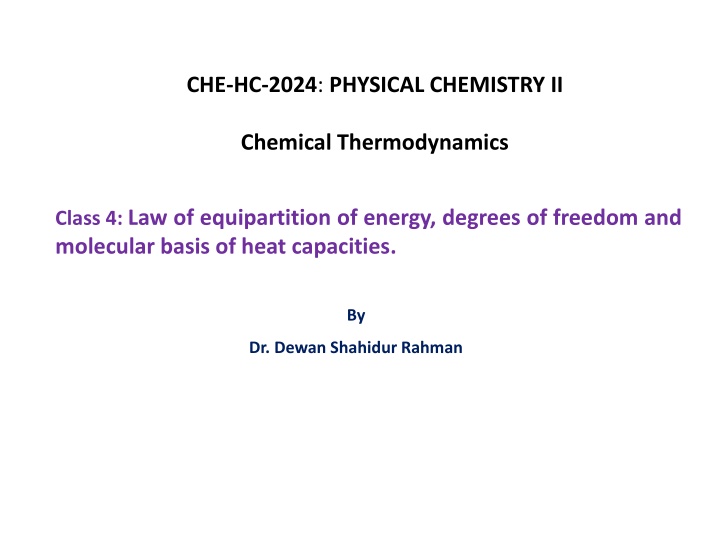
Chemical Thermodynamics: Law of Equipartition of Energy and Molecular Basis of Heat Capacities
Explore the fundamental principles of Chemical Thermodynamics Class 4, focusing on the Law of Equipartition of Energy, degrees of freedom, and the molecular basis of heat capacities. Understand how energy is distributed among molecular components such as translational, rotational, and vibrational motions. Gain insights into the average energy contributions of different components and their impact on the overall energy of molecules.
Download Presentation

Please find below an Image/Link to download the presentation.
The content on the website is provided AS IS for your information and personal use only. It may not be sold, licensed, or shared on other websites without obtaining consent from the author. If you encounter any issues during the download, it is possible that the publisher has removed the file from their server.
You are allowed to download the files provided on this website for personal or commercial use, subject to the condition that they are used lawfully. All files are the property of their respective owners.
The content on the website is provided AS IS for your information and personal use only. It may not be sold, licensed, or shared on other websites without obtaining consent from the author.
E N D
Presentation Transcript
CHE-HC-2024: PHYSICAL CHEMISTRY II Chemical Thermodynamics Class 4: Law of equipartition of energy, degrees of freedom and molecular basis of heat capacities. By Dr. Dewan Shahidur Rahman
Law of Equipartition of Energy The average energy of a molecule can be calculated with the help of the classical law of equipartition of energy. This law may be stated as: If the energy of a molecule can be written as in the form of sum of terms, each of which is proportional to the square of a velocity component (or to the square ? ??? to of a position coordinate), then each of these square terms contributes the average energy. The above law can be derived by evaluating the average value of the x- component of average kinetic energy with the help of Maxwell s distribution law. Therefore, kinetic energy ?? = ? =? ?? ??=? ???
Now the mean square velocity can be written in terms of its components as ??= ??+ ??+ ?? ?,? and ? are velocity component in ?,? and ? direction respectively and their values are equal. i.e., ??= ??= ?? Thus, ? =? ?? ??=? ?? ??+ ??+ ??=? ????=? ??? This gives, ? ????=? ??? Similarly, ? ????=? ??? and ? ????=? ??? Thus, the average total kinetic energy can be divided into three components, each of which is proportional to the square of the velocity component and thus contributes ? ??? to the average energy.
Translational Motion The translational energy of a gas molecules is ??????=? Since each term is proportional to the square of a velocity component, each contributes ? ??? to the average energy. Thus, the translational contribution is ??????=? ?? ??=? ????+? ????+? ???? ??? +? ??? +? ??? =? ??? Rotational Motion The rotational energy equation is given by ????=? ????=? Since each term in the above expression is proportional to the square of a velocity component, it contributes on an average? ??? to the average rotational energy. Thus, the average rotational energy of a linear molecule =? ??? = ?? The average rotational energy of a nonlinear molecule =? ?+? ?+? ? ?+? ????? ????? ????? ????? (for linear molecules) ? (for nonlinear molecules) ????? ??? +? ??? +? ??? +? ??? =? ???
Vibrational Motion The no. of vibrational modes = (?? ?) (for a linear molecule) = (?? ?) (for a nonlinear molecule) These describes the bond length and bond angles within the molecules due to the vibrational motion (stretching or bending) of the molecule. The vibrational energy stored in each of the vibrational mode is given by ? ????=? ?? ?? +? ? ?? ???? ?? according to the law of equipartition of energy, it becomes ????=? ??? +? ??? = ?? Thus, each vibrational mode contributes on an average ?? towards the total average energy. Thus, total average energy due to their vibrations in Linear molecules is (?? ?)?? Nonlinear molecules is (?? ?)??
The total average energy contributes due to all the three modes is: For linear molecule ? ??? ? ??? ???????= + + (?? ?)????? ????? ??? For nonlinear molecules ? ??? ? ??? ??????????= + + (?? ?)????? ????? ??? Total Energy of the Molecules The total average energy stored by the molecules in one mole of the gas is ???????= ?? ???????=? ??????????= ?? ??????????=? ??? + ?? + ?? ? ?? ??? +? ??? + ?? ? ?? For monoatomic gas ? = ? and thus, the total degree of freedom are three. These are the three motion along the ?- , ?-, and ?- axes. Thus average energy ? =? ??? per molecule ? =? ??? per mole
Molar Heat Capacity of Gases Molar heat capacity at constant volume of a gas can be obtained by differentiating molar energy with respect to temperature. Thus, we have Monoatomic gases ?? ???=? ? ?? ??,?= ?? ??,?= and ? =??,? =? ?= ?.??? ??,? Polyatomic gases ?? ???=? ??,?= ?? + ? + ?? ? ? (for linear molecules) ?? ???=? ?? +? ??,?= ?? + ?? ? ? (for nonlinear molecules)
Molar Heat Capacities for Diatomic and Triatomic Molecules The heat capacities of diatomic molecules ? = ?. ??,?=? ?? + ? + ? =? ? =??,? ??,? ? ?? ??, & ??,?= =? ?= ?.??? The heat capacities of triatomic molecules ? = ? For linear (CO2) ??,?=? ?? + ? + ?? =?? ? =??,? ??,? ?? ?? ??, & ??,?= =?? ??= ?.??? For nonlinear (H2O) ??,?=? ?? +? ?? + ?? = ????,?= ?? ? =??,? =? ?= ?.??? ??,?
